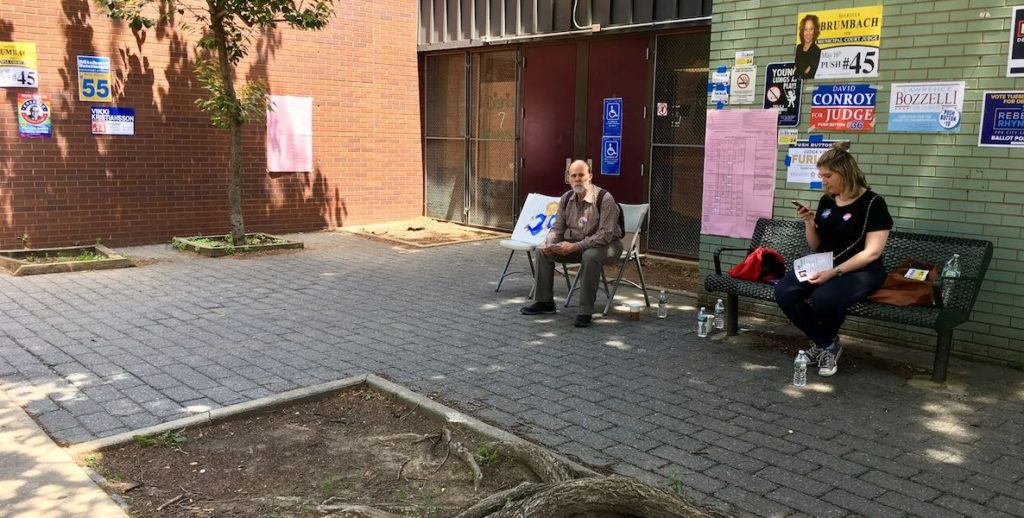While any election is exciting—particularly for the political junkies of “Reality Check,” my WURD afternoon drive time radio show—one couldn’t help but notice the Ghost of Low Voter Turnout haunting voter mood once more. Even as a flurry of Democratic District Attorney candidates such as Larry Krasner, Tariq El-Shabazz and Joe Khan called in to “Reality Check” just a few hours shy of poll closing, listeners heard the spitty pessimism bubbling from the throats of worn out pols.
Krasner and El-Shabazz were particularly cantankerous about near empty polling locations; Khan kept a sunny spin on it, though, just happily skipping on the campaign trail and thankful for the free air time—as his campaign, noticeably, didn’t buy an ad on the state’s only black-owned talk radio station. Neither did the FOP-backed Rich Negrin, who cleverly deployed consultant Dan Siegel to sneak in a few pro-Negrin fist pumps during the weekly Reality Check “Strategist” segment. But, even Siegel acknowledged turnout wasn’t looking so good that day.
Yet, let headlines and reigning wisdom from that day tell it, and Philadelphia witnessed a near holy, comet-sighting surge of voters. Everyone was dancing to their polling place to pick the next D.A., the next City Controller and a bunch of nameless judges for state and local benches. “Some signs of better turnout,” said philly.com; Billy Penn hailed it as a “major increase” and a “huge bump;” WHYY whispered rumors of a mystical “progressive, anti-Trump surge.” State Democratic Party Chair Marcel Groen even kicked off his “Reality Check” appearance that day full of talking-point exuberance over “good turnout.”
Maybe on the scale of low expectations it was impressive. City Commissioner Al Schmidt shows us, in the dandy Philly yellow-and-blue graph below, that turnout was at 17 percent on Tuesday—8 whole percentage points above the 9 percent it was in 2013 (at the re-election of presently disgraced DA Seth Williams). It’s also 5 points above 2009 turnout, when Williams was elected the city’s first black DA; in 2005, it was only 14 percent. Something in the Schuylkill, we don’t know, accounts for that bad 8 percent drop in turnout from 21 percent in 2001.
Giving conventional wisdom a little benefit of the doubt, maybe there was an anti-Trump surge this week, just months after November’s electoral Armageddon. Just like, in 2001, there could have been an anti-Bush surge only months after that President pretty much won by hanging chad technicality and a chummy Supreme Court (not to mention an epic failure of a candidate in Al Gore). So, maybe it really does take disastrous (for the left) on-cycle presidential election outcomes to motivate Democratic voters in the off-cycles.
But, seriously, how is 17 percent turnout something to celebrate in this day and age of Trumpism? Really? There’s nothing for Philly and, especially, Philly or Pennsylvania Democrats to pat themselves on the back about. This wasn’t just any off-cycle election. This was the off-cycle DA election triggered by the constant drum of legendary corruption and bribery headlines for the current DA (who’s still there).
Millennials, shell shocked by November, were supposed to also step up. And this is where Democrats were supposed to test run post-2016 voter mobilization muscle much like the kid overtaken by the fresh smell of new kicks. Even this publication’s very own $5,000 voter lottery wasn’t enough to get Philly voters to cross the 20 percent threshold.
Let’s throw some more perspective (and shade on that): There are 1,034,167 total registered voters in Philadelphia (see here)— out of 1,526,006 residents. Which means 68 percent of the population is registered to vote. But 17 percent of registered voters is barely … 176,000 residents.
We just let 11 percent of the city’s population tell us what to do and how to live.
Let headlines and reigning wisdom from that day tell it, and Philadelphia witnessed a near holy, comet-sighting surge of voters. Maybe on the scale of low expectations it was impressive. But, seriously, how is 17 percent turnout something to celebrate in this day and age of Trumpism?
More telling, as Econsult Solutions shows us, is that–once again–the city’s elections are decided more by zip code and less by political imperative or civic necessity. Where you live dictates how much you vote: In this case, there was near non-existent voter turnout in Philly’s poorer sections, as opposed to much higher interest in University City and Center City. North Philly shows deep pockets of dismal turnout.
That presents a rather thorny dilemma for Democrats in desperate need of comebacks in several upcoming elections, including Georgia’s 6th Congressional, the New Jersey and Virginia gubernatorial races in 2017, and the 2018 Congressional midterms: How will you pose any electoral threat to Congressional Republicans and their leader if you can’t inspire the black, brown and economically challenged populations disproportionately attacked by them?
So, what’s the Philly zeitgeist so damn happy about? Since 2016 was the Fate of the Republic election Democrats couldn’t win, any 2017 election (primaries included) should be a vigorous Retake the Republic moment where all hands are on deck—not a flat #Resist re-mix that didn’t make the Top 40. Voters, or those who should’ve voted, are just as complicit; folks are daily, hourly, every minute moaning in the grocery line or crying in the barber shop about “Trump this, Trump that” and those “corrupt politicians in City Hall.” But when it was time to show up for the easy part of the political process, 83 percent of registered voters just didn’t bother.
Charles D. Ellison is Executive Producer and Host of “Reality Check,” which airs Monday-Thursday, 4-7 p.m. on WURD Radio (96.1FM/900AM). Check out The Citizen’s weekly segment on his show every Tuesday at 6 p.m. Ellison is also Principal of B|E Strategy, the Washington Correspondent for The Philadelphia Tribune and Contributing Politics Editor to TheRoot.com. Catch him if you can @ellisonreport on Twitter.

